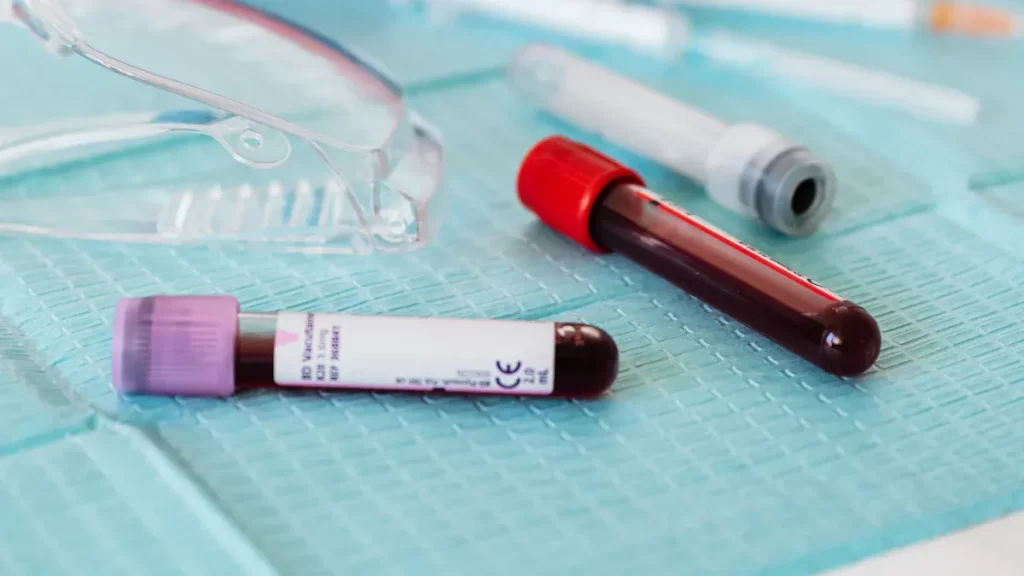News & Events
SSA Antibody Testing and Its Importance in Modern Autoimmune Diagnosis
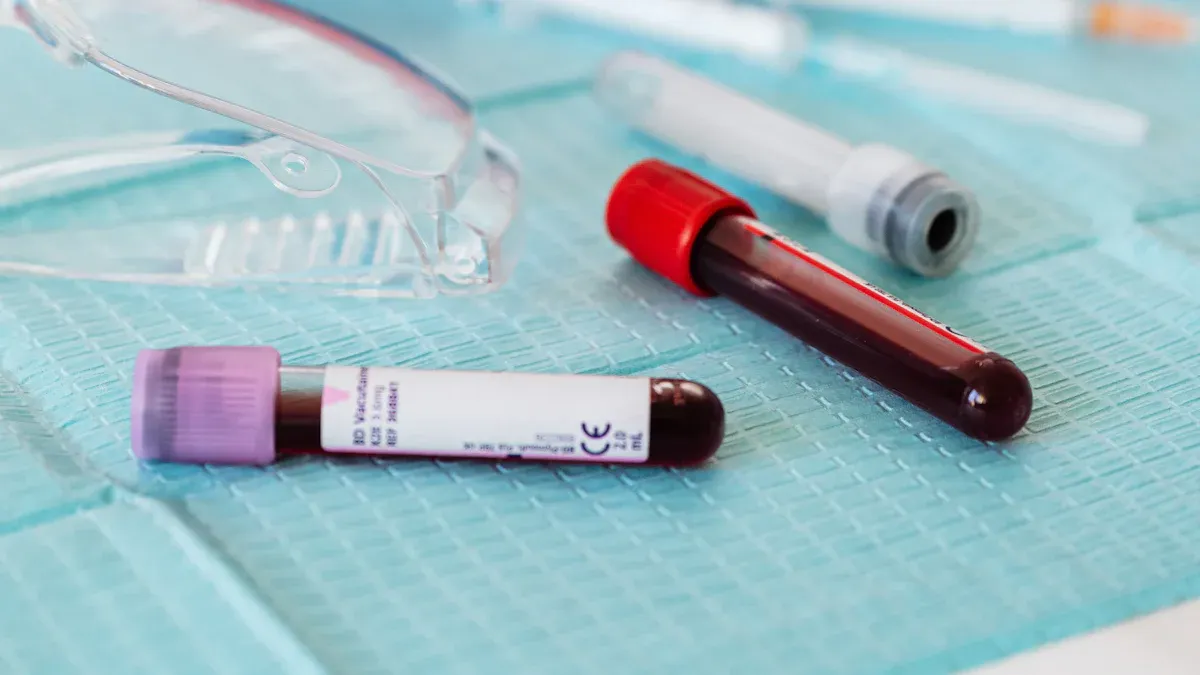
You may not realize how crucial SSA antibody testing is for uncovering autoimmune diseases. Anti-ssa antibody detection helps doctors distinguish between similar conditions because it offers high sensitivity and specificity.
- In a group of over 64,000 people, about 1.7% tested positive for SSA antibodies.
- Women showed a higher rate (2.7%) than men (0.9%).
When you explore your health, knowing your antibody status can guide important decisions.
Key Takeaways
- SSA antibody testing is crucial for diagnosing autoimmune diseases. It helps doctors differentiate between conditions like Sjögren’s syndrome and systemic lupus erythematosus.
- A positive SSA antibody test indicates the presence of autoantibodies, which may suggest an autoimmune disease. However, healthy individuals can also test positive.
- Understanding your SSA antibody status can guide treatment decisions and help monitor disease progression. Regular testing can improve long-term health outcomes.
SSA Antibody in Autoimmune Diagnosis
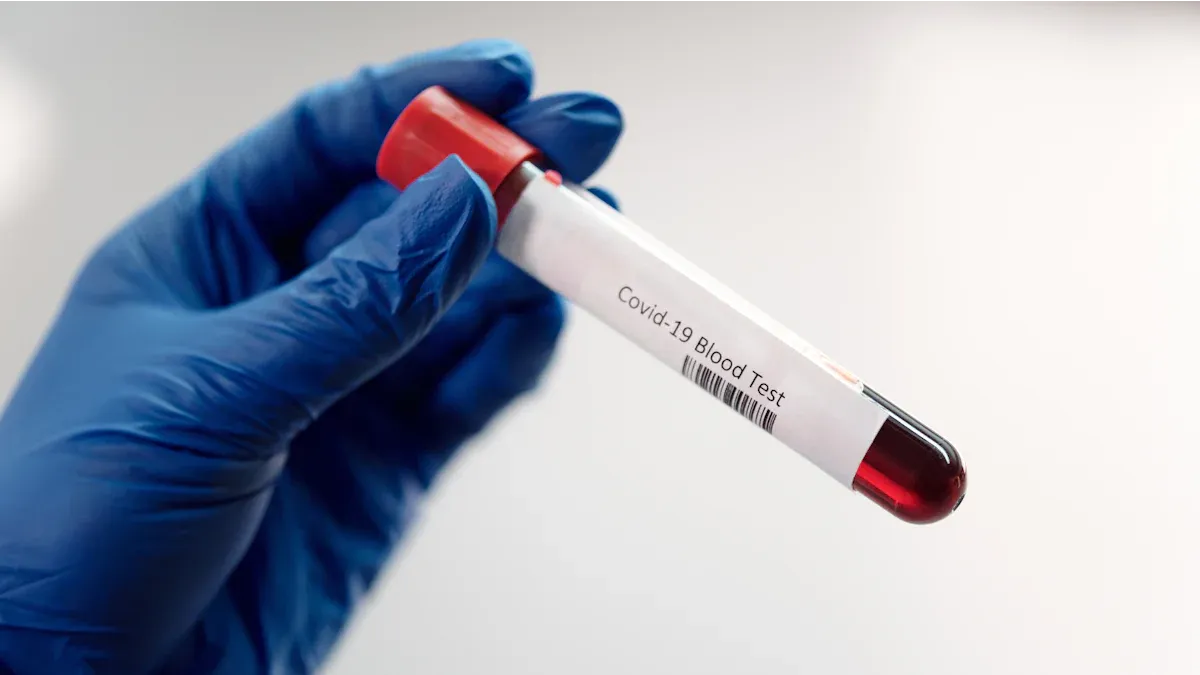
Diagnostic Role
You may wonder how doctors use ssa antibody testing to help with diagnosing autoimmune conditions. This blood test looks for anti-ssa/ro antibodies, which play a key role in identifying autoimmune diseases. When you have symptoms like dry mouth, joint pain, or skin rashes, your doctor may order this test to check for these antibodies.
Anti-ssa/ro antibodies appear in both Sjögren’s syndrome and systemic lupus erythematosus. However, the presence of anti-ssa/ro antibodies can mean different things depending on the disease. For example:
- Anti-ssb/la antibodies are found mainly in Sjögren’s syndrome.
- Anti-ssa/ro antibodies show up in both Sjögren’s syndrome and systemic lupus erythematosus, but they point to different clinical situations.
| Antibody Type | Sjögren’s Syndrome | Systemic Lupus Erythematosus |
|---|---|---|
| Anti-Ro/SSA | 70–100% | Present in different contexts |
| Anti-La/SSB | 40–90% | Less significant association |
Doctors rely on these patterns to improve diagnostic accuracy. The ssa antibody test helps you and your doctor understand if your immune system is attacking your own tissues. This information guides the next steps in diagnosing autoimmune conditions.
The sensitivity and specificity of the anti-ssa blood test also matter. For Sjögren’s syndrome, the sensitivity of anti-ssa is 49% in whole saliva and 32% in parotid saliva. The specificity is higher, at 87.5% and 95.52% for whole and parotid saliva, respectively. This means the test is more likely to confirm the disease when you have it, but a negative result does not rule it out completely.
Associated Diseases
You may think ssa antibody testing only relates to one or two conditions, but anti-ssa/ro antibodies show up in many autoimmune diseases. Here are some of the most common:
- Systemic lupus erythematosus
- Sjögren’s syndrome
- SS/SLE overlap syndrome
- Subacute cutaneous lupus erythematosus
- Neonatal lupus
- Primary biliary cirrhosis
- Systemic sclerosis
- Polymyositis and dermatomyositis
- Rheumatoid arthritis
- Mixed connective tissue disease
When you see high levels of anti-ssa, your doctor may consider several autoimmune disorders. The presence of these antibodies can also help identify overlap syndromes, where more than one autoimmune disease affects your system at the same time.
SSA antibody testing also plays a vital role in maternal-fetal medicine. If you are pregnant and have anti-ssa/ro antibodies, your doctor will monitor you and your baby closely. These antibodies can cross the placenta and affect the fetal heart, leading to congenital heart block, a serious form of neonatal lupus. The risk is highest between 16 and 26 weeks of pregnancy. Even if you feel healthy, the presence of these autoantibodies can still pose a risk to your baby.
| Evidence Description | Key Findings |
|---|---|
| Maternal anti-SSA/Ro antibodies | Linked to congenital heart block in fetuses, a major manifestation of neonatal lupus. |
| Mechanism of antibody transfer | Antibodies cross the placenta into fetal circulation, affecting the fetal heart. |
| Risk period | Highest risk for congenital heart block occurs between 16 and 26 weeks of gestation. |
Doctors use this information to guide testing and treatment during pregnancy. Careful monitoring can help prevent or manage complications.
Prognostic Value
Knowing your ssa antibody status does more than help with diagnosis. It also gives important clues about how your autoimmune disease might behave over time. If you test positive for anti-ssa, you may face a higher risk of disease progression or more severe symptoms.
| Disease Condition | Association with SSA Positivity | Prognostic Implication |
|---|---|---|
| NMOSD | More severe disease activity | Earlier relapses |
| Multiple Myeloma | Higher risk of disease progression | Shorter progression-free survival |
For example, patients with anti-ssa/ro antibodies often have shorter progression-free survival. One study found that ssa-positive patients had a median progression-free survival of 17 months, compared to 44 months for ssa-negative patients. The risk of disease progression was almost three times higher for those with a positive result.
In systemic lupus erythematosus and Sjögren’s syndrome, high levels of anti-ssa can mean more active disease. You may experience more symptoms or need closer follow-up. Doctors use these levels to adjust your treatment plan and watch for complications.
| Antibody Type | Disease Condition | Correlation with Disease Activity |
|---|---|---|
| Anti-Ro/SS-A | Sjögren’s syndrome | Examined for correlation |
| Anti-La/SS-B | Systemic lupus erythematosus | Examined for correlation |
Tip: Early detection of anti-ssa/ro antibodies can help you and your doctor make better decisions about your care. Regular testing and follow-up can improve your long-term health.
SSA antibody testing gives you and your healthcare team a powerful tool for diagnosing autoimmune conditions, understanding your risk, and planning your treatment. By knowing your antibody status, you take an active role in managing your chronic autoimmune condition.
Testing and Interpretation
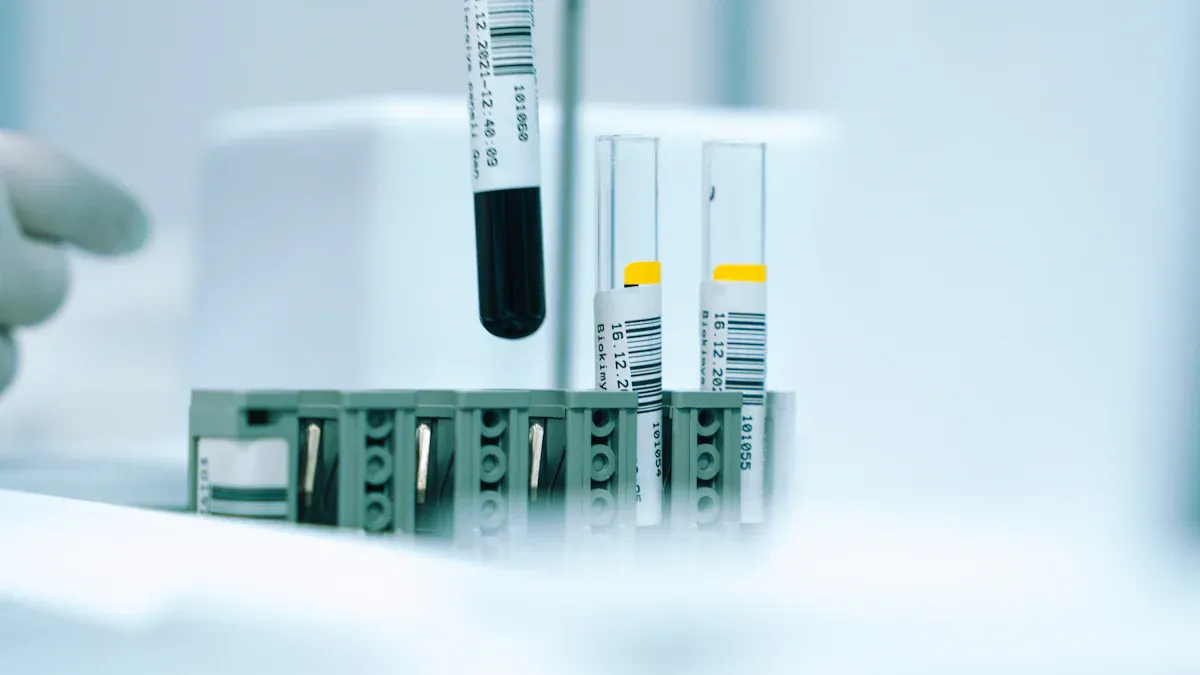
Test Procedure
You may wonder how doctors perform SSA antibody testing. The process starts with a blood test. Your doctor draws blood from your arm and sends the sample to the laboratory. The lab uses your serum to check for SSA antibodies. You do not need to prepare for this test. The collection method is simple, and the sample must be refrigerated to keep it stable.
| Step | Description |
|---|---|
| Collection Method | Blood Draw |
| Specimen Type | Serum |
| Test Preparation | No preparation required |
| Optimal Collection Volume | 4.5mL; full tube |
| Minimum Volume | 1 mL |
| Collection Instructions | Gently invert the sample 5-6 times after collection. |
| Specimen Transport | Refrigerate |
| Processing Instructions | 1. Allow the specimen to clot for 30 minutes. 2. Centrifuge specimen within 2 hours of collection. 3. After centrifugation, aliquot serum to a false bottom container. 4. Keep serum refrigerated until testing. |
| Specimen Stability | Refrigerated: 7 days; Room Temperature: 8 hours |
| Rejection Criteria | Hemolysis: Mild OK; Moderate OK; Gross Reject; Lipemia: Mild OK; Moderate OK; Gross Reject; Icterus: Mild OK; Moderate OK; Gross Reject; Other: Quantity not sufficient |
Laboratories use several methods to detect SSA antibodies. Some methods allow doctors to check for many antibodies at once. Others focus on one type. You may see SSA antibody testing included in the ANA panel, which screens for autoimmune diseases.
| Method Name | Description |
|---|---|
| Multiplex Flow Immunoassay | A method that allows simultaneous detection of multiple antibodies. |
| Indirect Immunofluorescence Assay | A traditional method for detecting antibodies using fluorescently labeled antigens. |
| Immunodiffusion | A technique that involves the diffusion of antibodies and antigens in a gel. |
| Immunoblot | A method that transfers proteins to a membrane for antibody detection. |
| ELISA | A widely used assay for detecting and quantifying proteins, including antibodies. |
Doctors choose the best method based on your symptoms and the suspected autoimmune disorder. Each method helps measure the levels of SSA antibodies in your system.
Result Meaning
When you get your SSA antibody test results, you may see either a positive result or a negative result. If you test positive, your body has SSA antibodies in your system. This can mean you have an autoimmune disease, but it does not always confirm the diagnosis. Sometimes, healthy people have SSA antibodies. The prevalence of SSA antibodies in healthy individuals ranges from 0.5% to 3%. Your doctor will look at your symptoms, your blood test results, and other factors before making a diagnosis.
- SSA antibodies can be detected in healthy individuals.
- The prevalence of SSA antibodies in the healthy population ranges from 0.5% to 3%.
If you receive a negative result, you may still have an autoimmune disorder. In a study of 934 patients with primary Sjögren’s syndrome, 32% tested negative for anti-SSA and anti-SSB antibodies. Many of these patients still showed signs of autoimmune disease. For example, patients with negative results had a higher rate of abnormal Schirmer I tests and interstitial lung disease.
| Clinical Feature | Anti-SSA/SSB Positive | Anti-SSA/SSB Negative |
|---|---|---|
| Proportion of Females | 90.6% | 75.3% |
| Thrombocytopenia | 13.6% | 6.7% |
| Abnormal Schirmer I Tests | 89.1% | 96.0% |
| Interstitial Lung Disease (ILD) | 28.8% | 59.2% |
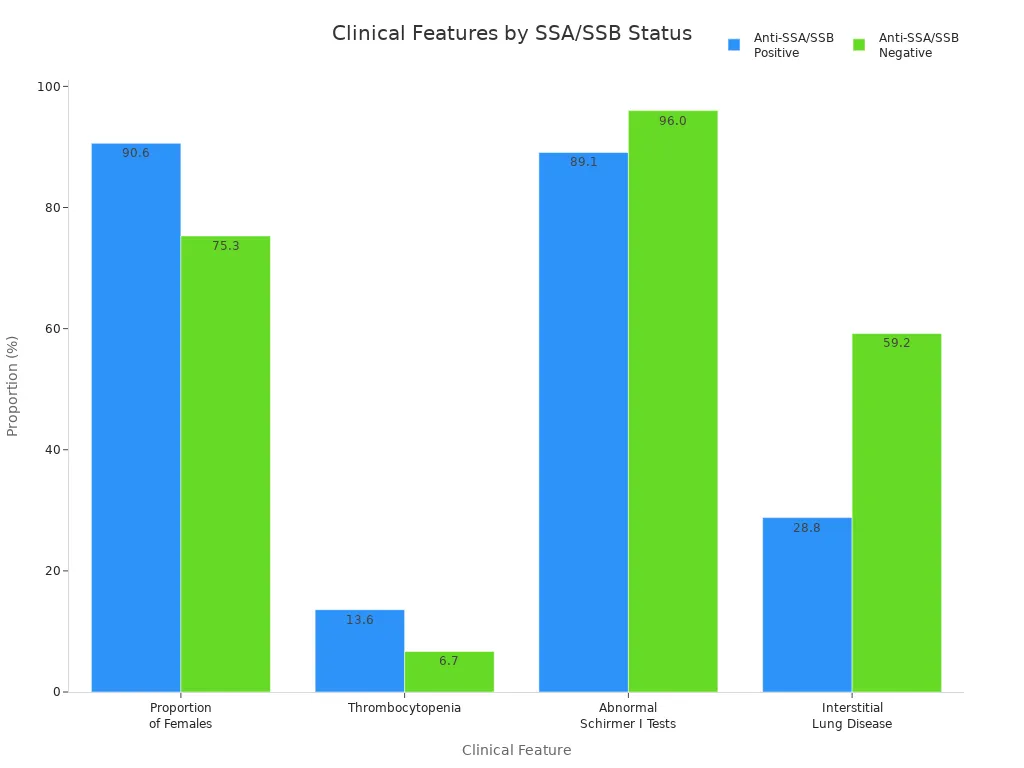
Doctors know that negative results do not rule out autoimmune diseases. You may need more tests to confirm the diagnosis. Your symptoms and other blood test results help guide your care.
Note: Your doctor will use your SSA antibody levels, your symptoms, and other tests to make the best diagnosis for your autoimmune condition.
Limitations
SSA antibody testing helps doctors diagnose autoimmune diseases, but it has some limits. Sometimes, the test gives false positive results. This happens because some methods have high sensitivity but low clinical specificity. You may get a positive result even if you do not have an autoimmune disorder. Doctors use SSA antibody testing in selected patients to make sure the results are meaningful.
| Evidence Description | Findings |
|---|---|
| Discrepancies in SSA antibody testing | 275 out of 570 ANA-negative samples showed discrepancies in results. |
| Positive results in confirmed cases | All 67 patients with SSA/Ro antigen showed positive results confirmed by double-immunodiffusion. |
| Limitations of HEp-2 cell line | The HEp-2 cell line’s origin from laryngeal carcinoma is a fundamental limitation affecting test accuracy. |
Some labs use the HEp-2 cell line for testing. This cell line comes from laryngeal carcinoma, which can affect the accuracy of the test. You may see different results depending on the method used.
SSA antibody testing is not perfect. You may need more tests if your results do not match your symptoms. Doctors may order follow-up testing or other blood tests. Your treatment should focus on your symptoms, not just your antibody levels.
- Additional testing or follow-up testing may be necessary.
- Treatment decisions should be guided by symptoms rather than solely by antibody test results.
- Regular surveillance for B-cell lymphoma is crucial for patients with Sjögren syndrome due to a significantly higher incidence compared to the general population.
Tip: Always talk to your doctor about your SSA antibody levels and your symptoms. Your doctor will help you understand your results and plan your next steps.
SSA antibody testing helps you and your doctor confirm autoimmune diseases and guide treatment. Careful interpretation matters because symptoms and other tests, like salivary gland ultrasound or Schirmer’s test, provide key clues.
| Diagnostic Modality | Key Finding |
|---|---|
| Salivary Gland Ultrasound | Grade 3 predicts positive biopsy |
| Schirmer’s Test | Assesses tear deficiency |
Always talk with your healthcare provider for advice tailored to your needs.
FAQ
What does a positive SSA antibody test mean for you?
A positive result means your body makes SSA antibodies. You may have an autoimmune disease. Your doctor will check your symptoms and other tests.
Can you have SSA antibodies without being sick?
Yes, some healthy people have SSA antibodies. Studies show 0.5% to 3% of healthy people test positive.
Should you repeat the SSA antibody test?
If your symptoms change or your doctor needs more information, you may need another test. Always follow your doctor’s advice.

